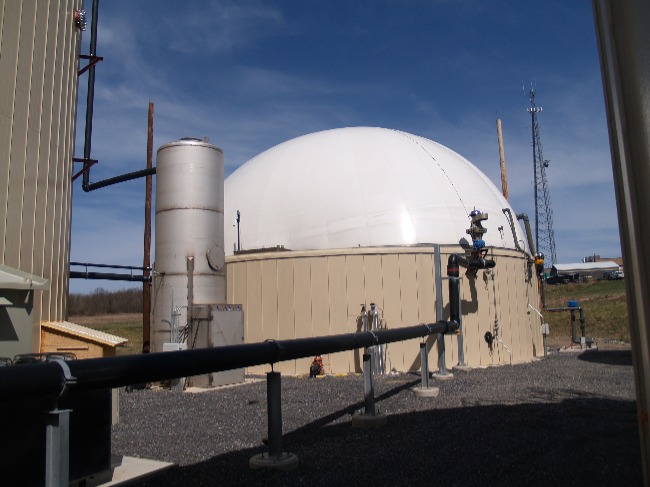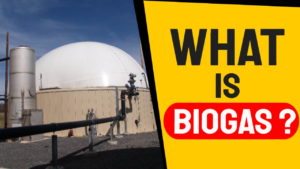So, What is Biogas?
Biogas is a type of biofuel that is naturally produced from the decomposition of organic waste. When organic matter, such as food scraps and animal waste, break down in an anaerobic environment (an environment absent of oxygen) they release a blend of gases, primarily methane and carbon dioxide. Because this decomposition happens in an anaerobic environment, the process of producing biogas is also known as anaerobic digestion (AD).
Biogas is a combustible gas, produced by the fermentation (anaerobic digestion) of biomass. It is produced in AD plants by the fermentation of renewable raw materials and/or waste. For the utilization of biogas, the methane content is the most important parameter. The average amount of methane in raw biogas is 60%. If the biogas should be used as fuel or fed into the existing natural gas grid it needs to be upgraded.
What is Anaerobic Digestion?
The term “biogas” is used as a generic term for energetic gases, which are formed by microorganisms from biotic substances under anoxic conditions (sewage gas, landfill gas, fermentation gas).

Anaerobic digestion is a series of biological processes in which microorganisms break down biodegradable material in the absence of oxygen. One of the end products is biogas, which is combusted to generate electricity and heat, or can be processed into renewable natural gas and transportation fuels.
A range of anaerobic digestion technologies are converting livestock manure, municipal wastewater solids, food waste, high strength industrial wastewater and residuals, fats, oils and grease (fog), and various other organic waste streams into biogas, 24 hours a day, 7 days a week.
Separated digested solids can be:
- composted,
- utilized for dairy bedding,
- directly applied to cropland or
- converted into other products.
Nutrients in the liquid stream are used in agriculture as fertilizer.
Anaerobic digestion (AD) systems are also often referred to as “biogas systems. “depending on the system design, it can be combusted to run a biogas generator producing electricity and heat (called a co-generation system), burned as a fuel in a boiler or furnace, or cleaned to become “biomethane”.
What is a Biogas Generator
Theoretically, biogas can be converted directly into electricity by using a fuel cell. However, this process requires very clean gas and expensive fuel cells. Therefore, this option is still a matter for research and is not currently a practical option.

The conversion of biogas to electric power by a generator set is much more practical. In contrast to natural gas, it is characterized by a high knock resistance and hence can be used in combustion motors with high compression rates.
Some dairy farms and livestock operations use anaerobic digesters to produce bio-gas from manure and used bedding material from their barns.
Some livestock farmers cover their manure holding ponds (also called manure lagoons) to capture biogas that forms in the lagoons.
The methane in the raw gas can be burned to heat water and buildings and as fuel in diesel-engine generators to generate electricity for the farm. The EIA estimates that in 2018, about 29 large dairies and livestock operations in the united states produced a total of about 266 million kwh (or 0. 3 billion kwh) of electricity from AD.
The Advantages of Biogas
Biogas is a renewable sustainable energy as when it is done right new biomass growth occurs on a continuous cycle through an AD plant, and the nutrients are put back into the fields each time to grow the next round of organic waste. That way the biogas plant becomes carbon neutral, as long as no fossil fuels are used along the way.
Utilizing the energy from the fermentation of waste products such as manure, food and sewage, anaerobic digestion offers a route towards a ‘circular economy’ in the use of products beyond the end of their service life.
At last year’s international energy agency bioenergy symposium, Professor Jerry Murphy, director of the SFI Marei Centre at the UCC Environmental Research Institute, spoke of his belief that the use of anaerobic digestion is integral to the establishment of a successful circular economy.
“there are so many advantages to a AD system,”
Murphy said,
“from waste treatment, production of bio-fertiliser, generation of a renewable energy suitable for transport, heating or electricity, improved water quality and provision of jobs in rural communities. It is the full package”.
Biomethane – The New Way of Sustainable Biogas Use
The new method of transforming biogas into biomethane that goes directly into the local gas network has many advantages.
Wien Energie™ now provides its customers with biogas that is carbon dioxide neutral, and can be used for all purposes natural gas is used for, including gas-powered vehicles. The City of Vienna has thus taken yet another step towards boosting its share of renewable energies and reducing the amount of gas that needs to be imported.
Making biomethane allows for better capacity utilization because energy can now be “stored” directly where it is produced.
AD In Developing Countries
Anaerobic Digestion (AD) is one of the few viable alternatives to the burning dirty coal problem, or just simply the need to find energy at all other than burning forests in poor countries.
In 2014-15, about 20,700 lakh cubic meters of biogas is produced in the country which is equivalent to 5% of the total LPG consumption in the country. The government is also extending substantial subsidy for setting up of new AD plants. At a time when the viability and safety of energy alternatives is being debated, it is pertinent to look at one of the oldest renewable energy alternatives, biogas.
Biogas is an important source of green and clean energy. It is produced from biological breakdown of organic matter in absence of oxygen. It is a popular source of fuel in many parts.
Organic material such as animal dung, kitchen waste dead plants etc., is also disposed of with a much reduced environmental impact, after it has been digested.
Could use as gaseous fuel. Methane and carbon dioxide are two gases which provide good caloric values to biogas when used as fuel.
Biogas also has small quantity of hydrogen sulphide, moisture which causes pungent smell. The raw gas produced from the anaerobic disintegration of manure in small- pit is called gobar gas; it is estimated that over two million households in India are able to use “gobar gas”, due to the easy availability of cattle dung.
The AD plant is circular pit made of concrete with a pipe connection. The manure and waste material is directed to the pit through channels. The pit is also used waste water which helps in fermentation through bacteria. The gas pipe is connected to supply points. Biogas plant help in get rid of organic waste and cattle dung in safe manner otherwise which could have adverse impact to environment by releasing methane directly to environment and spread diseases. Biogas plant is very simple and environment friendly sustainable source of energy because more people and more cattle more waste and more dung available to use respectively.
Calorific Value of Biogas
The calorific value of biogas is derived from its methane content. Methane net calorific value = 35,865 kj · nm–3 (8,580 kcal · nm–3);
Hence, as biogas is not pure methane, it's net calorific value will vary depending on its methane content.
The net calorific value of biogas containing 65% methane = 23,300 kj · nm–3 or 5,550 kcal · nm–3.
The removal or transformation of carbon dioxide (via AD Plant upgrading) and the purification from other contaminants (biogas cleaning) are essential for increasing the calorific value of biogas, for use as a renewable natural gas substitute.
Therefore, the new trend in exploiting biogas as an alternative to natural gas, is to upgrade (purify) it to close to 100% methane. The recently growing demand for renewable energy has raised interest in using the AD process.
This is effectively placing the AD sector as a keystone in circular bio-based economy societies. The high demand is also paving the way for establishing new lower-cost/ more efficient technologies for upgrading the bio-gas quality.
CSTRs for Anaerobic Digestion
In at least three broad applications of large scale anaerobic digestion simple Continuous Stirred Tank Reactors (CSTRs) are perfectly adequate for digestion of wastes which readily hydrolyze.
Many AD companies offer CSTR Anaerobic Digestion Plant solutions focusing on wastewater containing a high concentration of soluble COD, such as:
- wastewater from breweries,
- paper mills, dairies,
- food-processing plants, and
- pharmaceutical companies.

In one case study, AD company Fluence added a continuous-flow stirred tank reactor (CSTR digester) to a large dairy processing plant in northeast Italy.
Because of market forces, the company was unable to use Scotta-Whey, a byproduct of ricotta cheese manufacturing, as animal feed.
Fluence stepped in with anaerobic digestion to turn what was a waste product into energy. The project, an upgrade to an existing wastewater treatment plant, was installed without a break in production.
Evidently the CSTR was successful, as four years later, the company contracted Fluence to enlarge the operation because of an increase in production.
Home Biogas Digesters
The HomeBiogas™ Biogas Digester Unit is new class of anaerobic digester, delivering flat packed biogas kits to support off-the-grid lifestyles.

It utilizes both food waste and animal manure, producing enough cooking gas on a daily basis for 3 meals and 10 liters of clean organic liquid fertilizer. HomeBiogas™ is as an outdoors unit exposed to weather.
The unit functions well in warm and hot climates where the average day/night temperature is more than 15°c.
Small-scale, or family-size AD units are most frequently found in India and China. However, the demand for such units is growing rapidly throughout the world thanks to more advanced and convenient technologies, such as HomeBiogas™.
As the modern world is producing more and more waste, individuals are eager to find ecologically sustainable ways to treat their organic trash. Traditional systems typically found in India and China focus on animal waste.
Due to a lack of energy in rural areas combined with a surplus of animal manure, house or community scale biogas digesters are very popular, useful, and even life-changing in these countries.
In many developing countries, biogas digesters are even subsidized and advocated by the government and local ministries, who see the variety of benefits produced from using this gas. In addition to having a clean renewable energy provide gas in the kitchen, many families make extensive use of the fertilizer by-product that AD plant digesters provide.
Now we are returning to discuss large scale anaerobic digestion or biogas plants:
Biogas Plant Design
An anaerobic digestion system is made up of several key components.
Designs usually include the following features in addition the the CSTR (the digester or AD reactor tank):
- manure collection systems
- a storage facility for digester effluent, or waste matter
- biogas handling systems
- gas monitoring and flow control devices delivering gas to a gas use device.
A manure collection system is needed to gather manure and transport it to the digester. Existing liquid/slurry manure management systems can usually be readily adapted to deliver manure to the anaerobic digester.
Anaerobic digesters, commonly in the form of covered lagoons or tanks, are designed to stabilize manure and optimize the production of methane.
In the biogas handling system, the raw gas is collected, treated, and piped to the gas use device.
Biogas is most often used:
- to generate electricity,
- as a boiler fuel for space or water heating, upgraded to natural gas pipeline quality, or
- for a variety of other uses.
Flares are also installed to destroy extra gas and as a back-up mechanism for the primary gas use device.
Sustainable Biogas Heating Systems
A biogas heating system, on-site, or (with AD plant upgrading and Natural Gas grid injection) relies on the natural interaction between microorganisms and organic wastes. These being such as manure, sewage, agricultural by-products, and discarded food. Being used to produce a clean and energy-efficient burnable biogas.

Whether it's a private on-site system, or using biogas after “upgrading”, the gas is distributed through a network of pipes and is used for cooking and heating.
This is done in the same way that many of us use natural gas from our local utility provider. With the simple strike of a match and turn of a knob, a family has a safe gas for their stove. Very importantly though, this comes courtesy of their friendly neighborhood microorganisms, and not through using climate change inducing fossil fuel energy.
Communities and businesses across the country use biogas to:
- power engines, produce mechanical power, heat and/or electricity (including combined heat and power systems);
- fuel boilers and furnaces, heating digesters and other spaces;
- run alternative-fuel vehicles; and
- supply homes and business through the natural gas pipeline.
How it is used and how efficiently it’s used, depends on its quality. Nowadays, it is often cleaned to remove carbon dioxide, water vapor and other trace contaminants, when it is known as biomethane.
Removing these compounds from the raw digester gas often pays, because it increases the energy value of the it per unit volume (at constant pressure), and also raises the market value of the gas substantially.
Biogas Power Generation
New Zealand and Australia have a successful, internationally renowned and growing Anaerobic Digestion sector, with several consultancies and equipment suppliers implementing projects at home and abroad.
Projects currently in progress or recently commissioned are centered around “waste to energy” applications.
The development of these plants is supported by a well-informed and skilled research sector.
The current estimate of total amount of methane collected and used as biogas in New Zealand is around is as yet small compared with the leading AD nations, at just 50 megawatts (MWe).
Nevertheless, that's enough energy to power 40,000 households, although most of the current biogas produced is used for heat and electricity in industry-scale applications.
There is huge potential to increase rural AD plant generation capacity from food and animal waste in New Zealand and Australia. Increased separation of organic material from the waste stream could lead to the development of dedicated bio-reactors in all major population centers.
The biogas produced by anaerobic digestion is then suitably treated to power the internal combustion engine of the co-generation plant and produce, at the end of the process, entirely renewable electrical and thermal energy.
Conclusion
 With many local communities globally now declaring a climate change emergency, there is also rising awareness of anaerobic digestion and biogas.
With many local communities globally now declaring a climate change emergency, there is also rising awareness of anaerobic digestion and biogas.
It is being recognized as one of the few, if not the only way to dispose of organic wastes, such as food waste and agricultural waste without it creating even more methane greenhouse gas, in farm slurry tanks, or landfill sites.
In the developing nations it has all the same benefits, but also provides a domestic cooking fuel which is healthy when burnt in stoves and ovens etc, and removes the need for wood to be collected for cooking fuel thus avoiding further depleting global forests.
As communities and politicians wake-up to all the advantages of anaerobic digestion, and further research yields additional efficiencies in the process, the future looks extremely bright for the technology.



